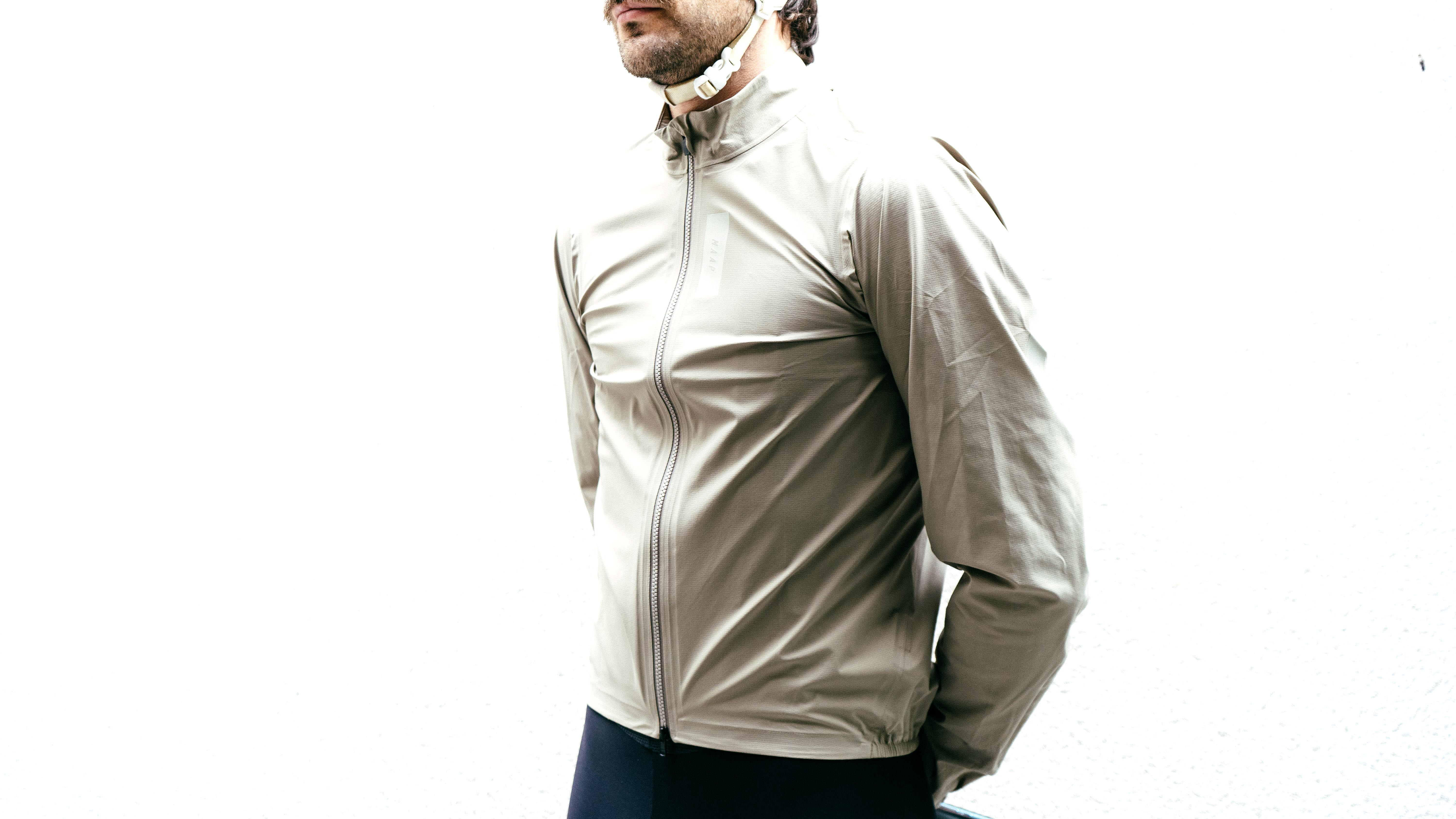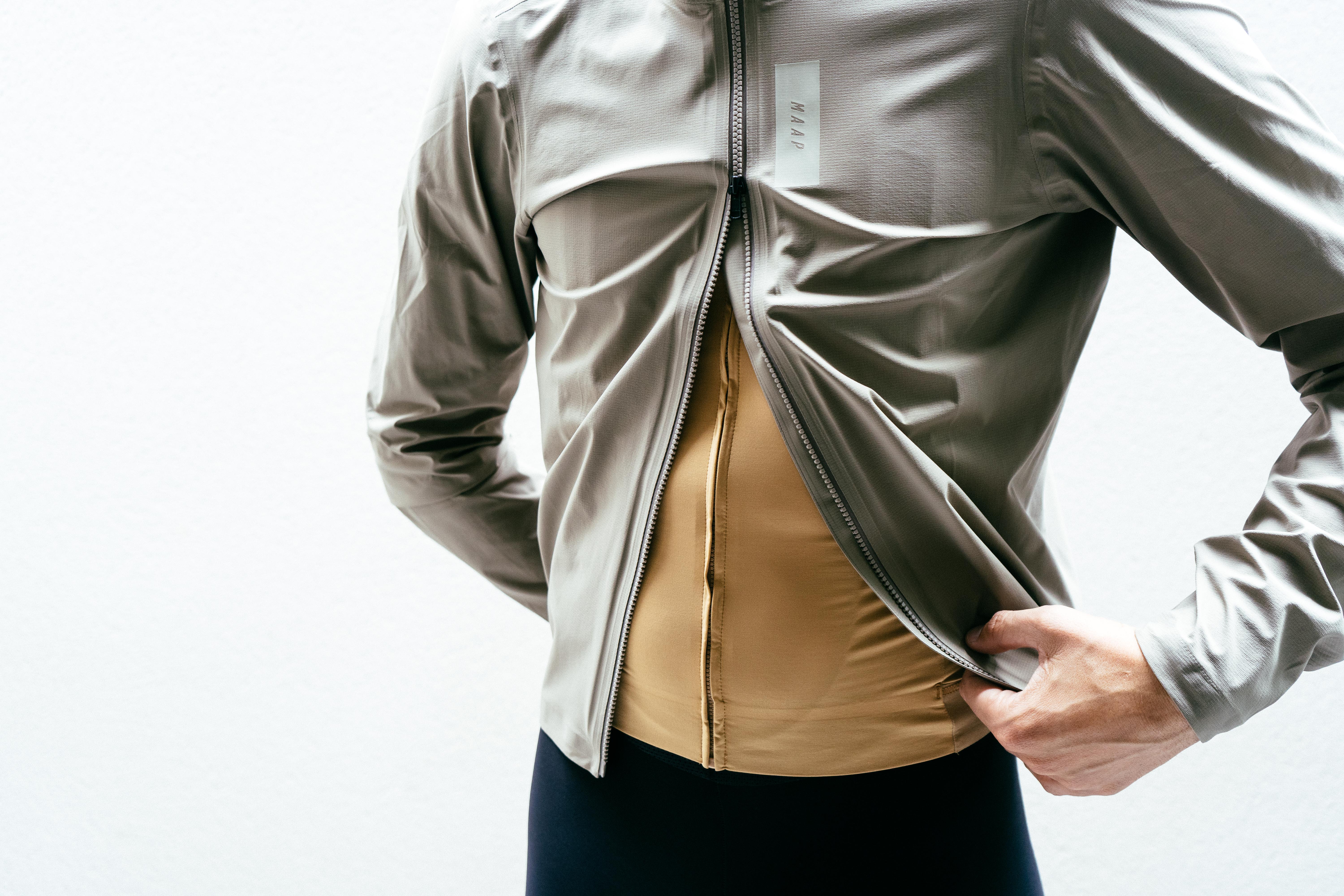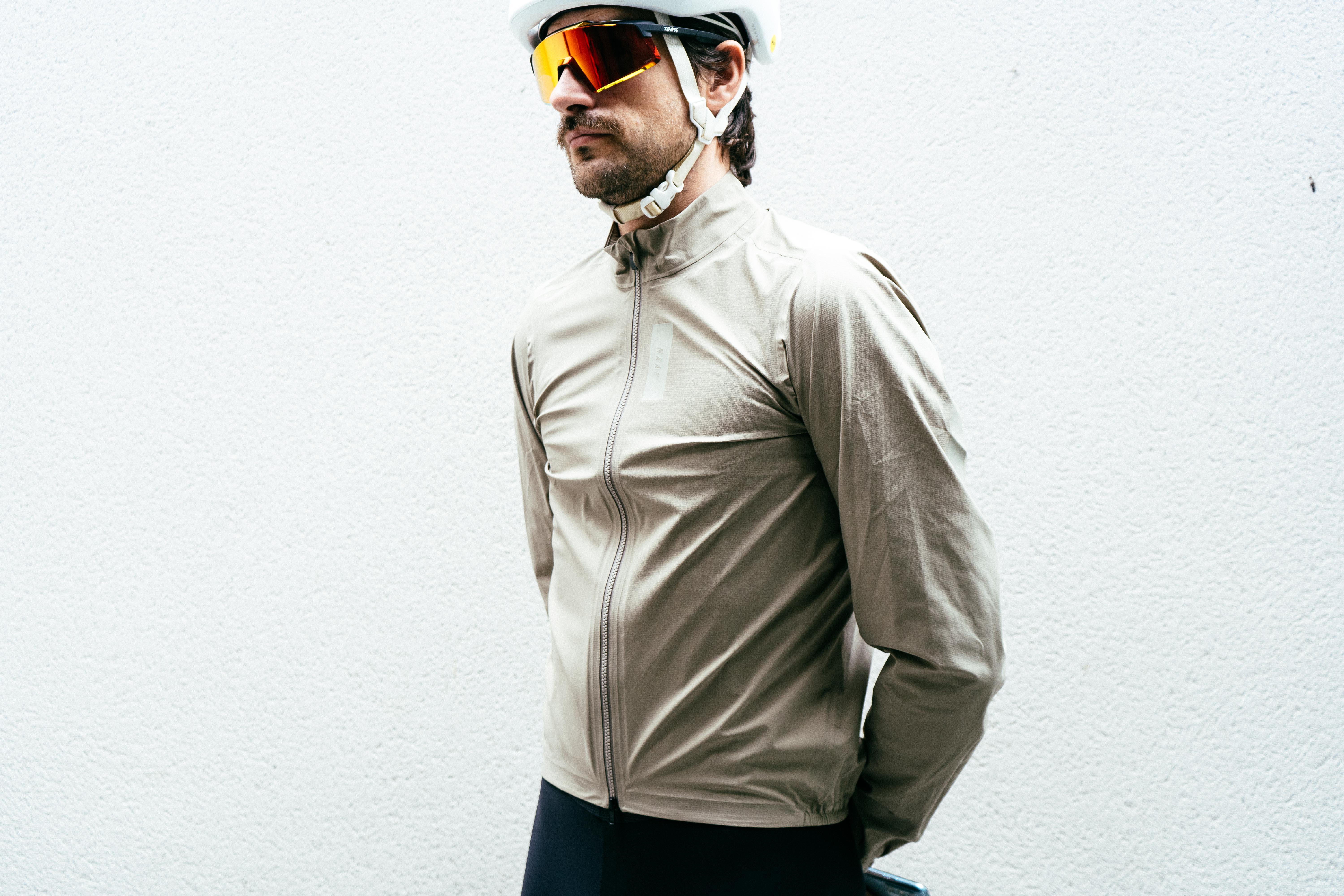
I am almost duty bound at the start of every waterproof jacket review I write nowadays to outline the changes in the waterproof garment industry. Much is changing thanks to the ban on PFAS - so-called ‘forever chemicals’. On the whole this is a good thing for the environment, and a bad thing for staying dry; modern, post-ban tech chemically isn't as good, particularly in the case of durable-water-repellent (DWR) treatments.
One positive thing I have noticed though, in my third year of curating our guide to the best waterproof cycling jackets is a shift in consumer focus away from simply chasing the most waterproof option in favour of a more balanced approach taking into account breathability and other factors. This is a good thing and has shifted the market away from simply plonking anything Gore-Tex at the top of the tree by default, and I have seen far more jackets utilising Pertex Shield in recent months than I have anything else.
One such jacket is the Maap Atmos. I’ve had my test sample on the go since spring, and it’s seen use in summer storms into the first of the autumnal downpours. It is, to my mind, the best packable jacket on the market at the moment, offering a reassuring level of protection given the fact it can compress down to about the size of a large apple. It’s not something I’d recommend if you want to ride through the winter, but for spring/fall changeable rides, summer storms, and those who want to pack as light as possible, it’s very hard to beat.




- Waterproof fabrics explained: What are they and how do they work?
Design and aesthetics
Less is more, or as the late, great Colin Chapman of Lotus put it: ‘Simplify, then add lightness’. The Maap Atmos is as simple as a waterproof jacket gets, to the point you’d be forgiven for mistaking it for a wind jacket or an old school ‘race cape’. Its lightness is the feature though, so this is what you are trading a lack of adjustability, and it must be said a degree of durability for.
Fit-wise it is another classic road silhouette, much the same as the Rapha Pro Team Gore-Tex I recently reviewed. The tail isn’t quite so long, I suspect in an effort to use as little material as possible. The rear hem is tightly elasticated by a thin strip though, and given the racy intentions it’s a fair assumption that you will likely be wearing a race-cut jersey underneath, which shouldn’t poke out and wick water up.
Like many race-fit jackets I went a size up than my usual jersey, and with that came quite a lot of room for layering underneath for a jacket that’s not really cut out for super cold conditions. In my correct size, I never found any tight spots or constrictions, and unlike many jackets, there’s a bit of stretch to the fabric too. I wouldn’t say you want to make it skintight for reasons I’ll go into soon, but it’s enough to accommodate broader shoulders or other anatomical differences.

Like the hem, and also like the Pro-Team GTX, the cuffs are only half elasticated. They’re not so tight as the Rapha option, and while they don’t do quite so well at keeping water out they are consequently much less of an impediment to quickly removing the jacket and stuffing it into a jersey, which really is the MO of the Atmos in my opinion.
You do get a double zip, which really is a must nowadays, and comes into play when using it as a wind jacket quite often. The real feature, if you can call it such, is the fabric itself. The 20,000mm rated Pertex Shield membrane is sandwiched between such thin face and liner fabrics that the jacket is almost translucent if you catch the light right. Its thickness is a bonus for packability. It does cause it to feel a little less sturdy and protective in bad weather, but more on that shortly.
Design notes aside, it’s aesthetically an attractive garment. It’s very much in keeping with the Maap branding, and like many other products in the brand’s range, it comes in a whole host of unusually named colour options (fungi, clay, muscat, bay…). There are some minimal contrast rectangles for a bit of visual intrigue, but that’s about it.




Performance
I’m going to start by outlining what this jacket isn’t for, that being something to keep you protected from the elements for hours on end in the cold. For that you need something with a bit more structural integrity like the Rapha Pro Team Gore-Tex Jacket. Its lightness means it's more easily distorted by the wind and particularly heavy rain, and can leave the fabric more likely to rest directly on your skin. Human skin doesn’t actually have any ‘wet’ receptors, only temperature and pressure, but if you have a gossamer-like fabric resting on your skin it’s going to feel cold, and it’s going to feel the pressure, and your brain will tell you that it's wet.
It can withstand some pretty protracted rainfall before it gets to this point however, but like so many jackets I’ve tested recently the DWR gives up the ghost on the leading edges, particularly if you’ve got a lot of high-speed descents. Once this happens you do end up with waterlogged fabric on your skin, and especially if you’ve got bare arms underneath this can feel like the membrane has failed. It hasn’t, but it does amount to much the same thing in terms of sensation. The flip side to this though is that the jacket dries out incredibly quickly once the sun comes out.
Considering how stuffable and feathery the Atmos is though, it does really make you rethink how you see waterproof jackets. For years the thicker and more sturdy a jacket fabric was, the more waterproof it ‘felt’, but by the numbers and in my experience this can keep the rain out in much the same way as far thicker jackets. The feeling of wetness I occasionally felt was simply a result of the fabric weight, rather than the membrane failing.
The packability is really the star of the show here, and it’s the reason it’s absolutely perfect for changeable conditions. In seconds you can stuff it into a jersey pocket or bar bag without having to meticulously roll it up to make sure it fits. The reverse is then true, meaning you can whip it out and sling it on as and when the heavens open - this is easily done no-handed if you’re confident thanks to the slightly looser cuffs I mentioned earlier, and a smoothly sliding zip. The zip is quite low profile so a little fiddly to locate, but it does become muscle memory after enough tries.
While it may not perform as well in sustained rain as something more sturdy, it outperforms almost every other waterproof I’ve tested (with the possible exception of the hooded Rab CNDR Phantom) in terms of its ability to be used as a replacement for a wind jacket. This is why I reach for it so much more often throughout the year than almost anything else. The double zip really helps the airflow, but the fabric itself is incredibly breathable for such a high hydrostatic head figure. Maap claims a 20,000g/m2 breathability, which is basically meaningless unless you’re a fabric tester. What it means in reality is that you can wear it to keep a cold breeze at bay without having to rely on the additional cooling properties of water falling from the sky to stay reasonably comfortable. It's only really surpassed in terms of breathability by the Castelli Gabba R, which isn't nearly as waterproof.
Basically, if you are riding in spring, summer, and autumn, but tend to avoid deep winter riding, it's going to be far more useful to you than a more hefty hardshell. To be honest, it’s so small it just lived on the bike a lot of the time, stuffed into a tool caddy, there if I ever needed it but taking up so little space I never bothered removing it.
I think a recent ride I did in wales sums up the perfect use case. A late-summer 200km hilly blast into Wales, with an hour or two of sustained rain near the start, bookended by blue skies. Light enough to not weigh me down, protective enough to shield my camera from a downpour for a time, and breathable enough that I didn’t end up a sweaty mess whenever the road pointed upwards. It didn’t stop me from contracting a particularly awful stomach bug from some farm effluent on the road, but I don't think any jacket could have done that. Ignore the change in colour of the jacket from the video to the photos in this review; the dark red one was my test unit, and the off-white one was just sent for photos as it's the new season colour.
Value
Putting my ‘if I was spending my own money’ hat on once more I can understand why seeing a $345/£270 price tag next to such a tiny garment might be a little jarring. Making something this light provide the protection of a large jacket is no mean feat, but more than that you’re getting something that will probably have far more use than a super-protective hardshell. In any other part of cycling nobody would bat an eyelid at paying more for something that's lighter, so why should clothing be any different?
The Atmos could also conceivably replace your wind jacket quite happily, and provide far more rain protection than that ever could. I’ve even packed it on those rides I'd usually take a gilet for a bit of extra ‘I know I’m covered’ protection.

Verdict
Gone are the days of choosing between getting soaked by the rain or getting soaked from your own sweat; the Maap Atmos sets the standard for packable, lightweight protection. It's sturdy enough to keep you covered for spring and summer drenching, and even into cooler autumn rides too. The POC Supreme did make a valiant case for itself in the initial post-Shakedry landscape, but in comparison, the Maap option fits better, has a better zip, and is a lot cheaper as well as being only a little larger when packed down.
Steer clear if you want a super sturdy all-season option, but in my view, something like this is probably going to be more useful to more people, unless you’re always heading out in the pouring rain.







